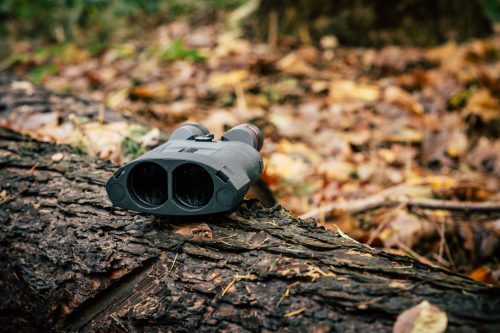If you are an outdoor enthusiast looking to enjoy outdoor activities such as birdwatching, stargazing, boating, or wildlife observation with the best image stabilized binoculars, you are in the right place. A quality pair of image stabilized binoculars is key to having clear and steady image views and we are here to walk you through the best models available on the market.
During use, traditional binoculars often struggle with the natural hand tremor, especially at higher magnifications. This is where image-stabilized binoculars truly shine. These sighting tools use advanced stabilization technology to deliver a clear and shake-free view, even at high magnifications. Besides, they offer the perfect blend of cutting-edge technology and superior optics to ensure every detail comes into sharp focus, no matter the distance.
How do Binoculars with Image Stabilization Work?
Image-stabilized binoculars use advanced technology to counteract shake and movement, delivering steady, sharp images even in challenging conditions. They employ gyroscopes or electronic sensors that detect movement and compensate for it, keeping the image steady and shake-free. The result is a smoother viewing experience, especially at long distances or high magnifications. Besides, these binoculars are versatile and ideal for extended use during dynamic activities like birding, sailing, or surveying vast landscapes.
Why Image Stabilized Binoculars?
If you’re often in situations that involve movement or require a high-powered binocular to acquire targets with ease, image-stabilized binoculars provide a significant advantage over traditional binoculars. These benefits include:
- Steady Viewing: Image stabilization reduces the effects of hand tremors or movements to provide a steady image even when using high magnifications or viewing from unstable platforms like a moving boat or vehicle.
- Extended Glassing Comfort: Holding binoculars for extended periods causes arm fatigue, leading to shaky views. Image-stabilized binoculars eliminate the need for a steady grip, offering a snug and relaxed viewing experience.
- Enhanced Clarity: Furthermore, the best image stabilized binoculars not only offer stable images but also improve the details you observe. This makes them ideal for wildlife observation, stargazing, birdwatching, or any outdoor activities where detail and precision matters.
- High Magnification Usability: With image stabilized binoculars, you can view targets at a distance with the highest zoom setting and not experience image shake. Stabilization compensates for this, making it easier to focus and enjoy distant objects without needing a tripod.
- Versatility: These binoculars work well in situations where using a tripod is impractical, such as viewing wildlife from unstable platforms like a moving vehicle and marine applications from a moving boat.
Top 7 Best Image Stabilized Binoculars
Below, we’ll explore the top-rated image-stabilized binoculars available on the market, highlighting their features, performance, and suitability for various outdoor enthusiasts. Let’s jump right in!
1. SIG SAUER Zulu6 FDE HDX OIS 16X42mm Binocular

Specifications
- Magnification: 16x
- Objective Lens Diameter: 42mm
- Weight: 21.9 oz
- Length: 7.08 in
- Prism Type: Schmidt-Pechan
- Eye Relief: 14 mm
- Field of View: 3.8º
The SIG SAUER Zulu6 FDE HDX OIS 16X42mm binoculars stand out as the best image stabilized binoculars. They are renowned for their Optical Image Stabilization (OIS) feature which makes them incredibly effective for handheld viewing at high magnifications.
Built with high 16x magnification, this pair of binoculars is ideal for viewing targets at extended distances. Coupled with HDX glass, it delivers crisp and clear images with exceptional brightness, even in low-light conditions. The enhanced clarity and color fidelity are vital for getting the most detail of targets.
Furthermore, the Field Dark Earth (FDE) finish gives these binoculars a tactical, rugged aesthetic, perfect for outdoor enthusiasts and hunters. It is also built with durability in mind to withstand abuse and rough handling.
Ergonomically, the Zulu6 feels comfortable to hold for extended periods. It is lightweight and compact for easy carrying in the field. Additionally, the controls are intuitive, and the OIS system, once activated, noticeably improves viewing stability, which is especially helpful at such high magnification.
Above all, these binoculars are 100% water-resistant and fog-proof for reliable use in various weather conditions.
Pros
- Excellent Optical Image Stabilization (OIS) for steady viewing
- 16x magnification provides sharp, high-resolution images
- High-quality HDX optics with great light transmission
- Durable and rugged construction, suitable for tough environments
- Compact and easy to carry
Cons
- Narrower field of view at 16x magnification
2. Fujifilm Techno-Stabi TS-X 14×40 Image Stabilization Binocular
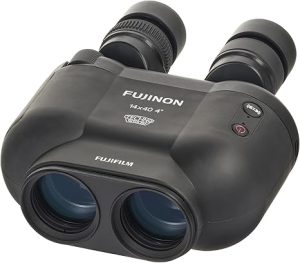
Specifications
- Magnification: 14x
- Objective Lens Diameter: 40mm
- Minimum Focus Distance: 16.4′ / 5 m
- Weight: 2.9 lbs / 1.32 kg
- Length: 7.07 in
- Prism Type: Reverse Porro
- Eye Relief: 13 mm
- Field of View: 210′ @ 1000 yd / 70 m @ 1000 m
The Fujifilm Techno-Stabi TS-X 14×40 Image Stabilization Binocular offers an impressive combination of high magnification, optical clarity, and advanced image stabilization technology. This makes it a versatile tool that meets the needs of every outdoor enthusiast out there.
With 14x magnification, these binoculars are ideal for long-distance observation. The powerful stabilization system effectively compensates for hand tremors and movement, providing a steady and clear image even with high magnification.
Furthermore, the binocular stands out in terms of optical performance. It delivers crisp and bright images with excellent color accuracy and contrast, thanks to multi-coated lenses that reduce glare and enhance light transmission.
Ergonomically, the TS-X 14-40 is designed with user comfort in mind. It features a rubberized armor that not only makes it easy to grip but also provides a level of shock resistance. Even better, the controls are intuitive, and the image stabilization feature is activated with a simple press of a button, allowing for quick and effortless adjustments.
Pros
- Ease of use
- Powerful 14x magnification
- Compact and durable construction
- Bright and clear optics
Cons
- Relatively heavier weight compared to standard binoculars
3. Canon Camera US 14×32 IS Image Stabilizing Binocular

Specifications
- Magnification: 14x
- Objective Lens Diameter: 32mm
- Minimum Focus Distance: 6.6 ft. (2m)
- Weight: 1.71 Pounds
- Prism Type: Porro Prism
- Eye Relief: 14.5 mm
- Diopter Adjust Range: +/-3.0 Diopters
Boasting a high magnification ratio of 14x, Lens Shift Image Stabilization, and a powered IS function, Canon’s 14×32 IS binoculars are perfect for bringing details up close while providing an impressively steady image. They are admirably easy to use and suitable for a wide range of outdoor adventure activities.
These binoculars deliver a bright, sharp, and easily sustainable view thanks to the field-flattening lens element. It counters the blurred effect typically rendered by the curvature of conventional lens elements, delivering a sharp, low-distortion image across the entire field of view.
Furthermore, the binocular features a super spectra coating on its lenses to effectively suppress reflected light across a wide range of wavelengths. This results in high contrast, high definition, and a clear viewing experience.
Thanks to an improved, ergonomic design, the 14×32 IS binoculars are easy and comfortable to use even for extended periods. They also bring to the table a minimum focusing distance of 6.6 ft. (2m) ideal for viewing animals, flowers, and other small objects from short distances.
Pros
- Highly effective lens shift image stabilization
- Improved design and comfortable grip
- Relatively lightweight and portable
- Bright and clear images with edge-to-edge sharpness
Cons
- Narrow eye relief
4) Kenko Image Stabilization Binocular VcSmart
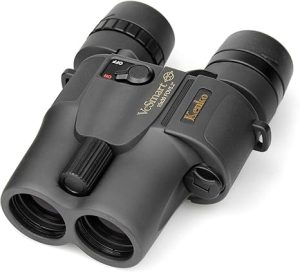
Specifications
- Magnification: 10x
- Objective Lens Effective Diameter: 30mm
- Field Of View (Degrees): 5.2°
- Field of View at 1000m: 90.8m
- Eye Relief: 14mm
- Shortest Focusing Distance: 3.5m
- Size: 147x51x124mm
- Weight: 515g(1.136 pound)
When it comes to versatility and performance, it is hard to go wrong with the Kenko Image Stabilization Binocular. It is a lightweight and extremely compact 14x magnification pair of binoculars with high-performance vibration control system.
The binocular compensates for shaking or vibration electrically to provide a crisp and shake-free image. The compact design fits even small hands, and its stamina allows 12 hours of operation with a single CR2 Battery.
Optically, this binocular is a force to reckon with. All lens surfaces and prisms have a full multi-layer coating that prevents light transmittance loss and minimizes any disturbing reflection for an extremely clear and bright view.
Furthermore, the binocular has a lightweight, and streamlined body for easy grip and operation. The chassis is made from hard-wearing materials and fully armored to be easy to grip without extra irregularities.
Another feature that makes it one of the best image stabilized binoculars is long eye relief. It provides a comfortable experience over a long time and with the twist-type eyecups, you can adjust the eyepoint for comfortable observation whether with the naked eye and when wearing glasses.
Pros
- Compact and lightweight design
- Good value for the price
- Streamlined body for easy grip and operation
- Long battery life
- Easy focusing and interpupillary distance adjustment
Cons
- Battery not included
5. Canon 10×42 L IS WP Image Stabilized Binoculars
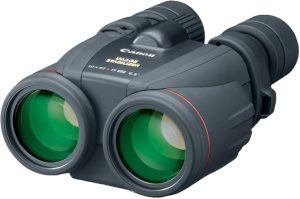
Specifications
- Magnification: 10x
- Objective Lens Diameter: 42 mm
- Exit Pupil Diameter: 4.2mm
- Apparent Angle-of-View: 65°
- Field of View: 6.5°
- Focus Type: Manual-focus
- Eye Relief: 16mm
Next, we have the Canon 10×42 L IS WP Image Stabilized Binoculars. This pair of image-stabilized binoculars is an exceptional choice for anyone seeking high-end optics with advanced stabilization technology.
These binoculars offer a 10x magnification, providing crisp, clear images even at long distances. Thanks to the advanced L-series glass elements and Super Spectra coating, maximum light transmission is guaranteed for enhanced clarity and reduced glare.
Another impressive feature of these binoculars is their image stabilization (IS). It effectively counters hand tremors and environmental movements, resulting in a steady view even without a tripod. Besides, the ergonomic design and comfortable grip make the binoculars easy to hold for extended periods, while the 42mm objective lenses deliver excellent optical performance, even in low-light conditions such as dusk or dawn.
More importantly, the Canon 10×42 L IS WP binoculars are well-suited for use in harsh weather conditions. They are rated as waterproof and fog-proof to be operable in extreme weather conditions. On top of that, they are durable enough to withstand rain, splashes, and even submersion, which makes them ideal for marine applications or extreme outdoor environments.
Pros
- Decent battery life
- Effective image stabilization
- Ergonomic design and comfortable grip
- Easy-access controls for stabilization activation
- Great value for the price
Cons
- Heavy
6. Kite Optics APC Stabilized 16×42 Binoculars

Specifications
- Magnification: 16x
- Objective Lens Diameter: 42mm
- Field of View (ft/1000 yards): 205
- Battery Life ( Hours): 120
- Degree of Stabilization: 2 Degrees
- Eye Relief: 14mm
- Weight: 21.9 oz
- Length: 7.1 in
Here is another high-powered image stabilized binoculars whose build quality and versatility are unmatched. It is an ideal companion fir hunting and shooting sports, hiking and outdoors, marine, and bird watching.
Just as light and just as bright as conventional 42mm roof prism binoculars, these binoculars offer a entirely new level of stability. You can use it observe targets in the strongest winds, observe as long as you like and see unmatched details, even with the high 16x magnification without the slightest image vibration.
More importantly, the Kite Optics APC Stabilized Binoculars binoculars are fully waterproof for use in all weather conditions. The optical system and electronics are sealed to result in an IPX 7 waterproof rating that can handle any kind of rain shower and can even be submerged to 1 meter depth for a maximum of 30 minutes. The system is also nitrogen gas filled which prevents internal fogging.
The stabilization capacity of the Kite Optics APC STABILIZED Binoculars goes beyond the suppression of image vibrations caused by wind or hand trembling. It features military-grade capacity stabilization system that allows stable viewing from driving vehicles, boats, aircrafts and other unstable platforms.
Pros
- 2° correlation angle
- Fully waterproof and nitrogen filled
- Lightweight design
- Great value for money
- Versatile
- Unmatched optical clarity
Cons
- Short eye relief
7. Canon 18×50 IS All Weather Image Stabilized Binoculars
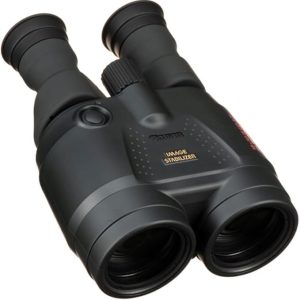
Specifications
- Magnification: 18x
- Objective Lens Diameter: 50mm
- Filter size: 58 mm
- Closest Focusing Distance: 19.7 feet
- Exit Pupil Diameter: 2.8mm
- Eye Relief: 15mm
Canon 18×50 IS All Weather Image Stabilized Binoculars are out last recommendation of the best image stabilized binoculars. These high-power binoculars incorporate an optical image stabilizer for shake-free viewing and minimal eye fatigue.
The system employs a Vari-Angle Prism, dual transparent plates, independent vertical and horizontal sensors, and a dedicated microprocessor to continuously adjust the prism to maintain a steady image. Furthermore, the controls for focusing and image stabilization are centrally located and accessible by both hands while the long eye relief ensure great glassing comfort with or without eyewear.
These 18×50 IS binoculars are built ready for outdoor use. They feature a water-resistant, shock-resistant rubber coating for a nonslip grip and better durability.
To complement the solid construction, these binoculars have a super spectra lens coating that enhances brightness of an image by fighting glare and enhancing light transmission. On top of that, the massive 50mm objective admits more light for brighter, more detailed images, even in lowlight situations.
Pros
- Superior low-light performance
- Generous eye relief
- Solid and reliable construction
- Effective optical image stabilizer
Cons
- Heavy
Best Image Stabilized Binoculars Buying Guide
When choosing image-stabilized binoculars, consider the following factors to ensure you get the best model for your needs:
Magnification
The magnification power in image-stabilized binoculars varies from one model to the other. Higher magnification provides a closer view but sacrifices the field of view. Determine your glassing needs and look for a binocular that offers meets those needs.
Objective Lens Size
Larger lenses (e.g., 42mm or 50mm) gather more light, which is useful in low-light conditions. However, they make the binoculars heavier so look for a model that offers good low-light performance without being bulky.
Image Stabilization Technology
Image-stabilized binoculars employ different stabilization technologies. Optical Image Stabilization (OIS) and electronic stabilization are the most popular technologies.
Binoculars with optical image stabilization use gyroscopic sensors and compensate for hand movements by adjusting the lenses or prisms. These binoculars are the most effective for reducing image shake.
Electronic Stabilization binoculars on the other hand use electronic systems to stabilize the image are found in some high-end models.
Build Quality and Durability
Image binoculars tend to cost more than most traditional binoculars. Look for a model that is waterproof and fog-resistant, especially if you plan to use it outdoors in various weather conditions. The best image stabilized binoculars should also have a durable chassis made with high-quality materials like magnesium alloy. In addition, the chassis should be rubber-armored to improve longevity and grip.
Field of View
Field of view refers to the total area you see without moving the binoculars around. A wider field of view allows you to see more of the scene at once, which is useful for tracking moving objects.
Eye Relief
The next thing to consider is eye relief which is the distance from the lens to your eyes while still seeing the full field of view. This distance is important to look at especially if you wear glasses. Look for a minimum of 15mm eye relief for comfortable viewing with or without eyeglasses.
Weight and Size
Image-stabilized binoculars tend to be heavier due to the stabilization mechanism. Consider if the weight is manageable for extended use and pick a model that will be easy to carry and use during lengthy glassing periods.
Battery Life
Most image-stabilized binoculars are battery-powered. Typically, the battery life depends on the model and usage. Some binoculars can last up to 100 hours on a set of batteries, while others might need more frequent changes. So, check the manufacturer’s specifications for details and pick a model with the longest battery life.
Price and Reviews
Image-stabilized binoculars are typically more expensive than traditional ones due to the advanced technologies they employ. Set a budget but be prepared to pay more for a higher-quality model.
With reviews, check reviews and user feedback to gauge real-world performance and reliability. Testing the binoculars in-store, if possible, can also help you make an informed decision.
How to Maintain Image Stabilized Binoculars
Caring for and maintaining image-stabilized binoculars involves a few key steps to ensure optimal performance and long-lasting durability. The steps include:
- Regular Cleaning: Use a gentle lens brush to remove dust and debris. Do not use paper towels or rough materials that might scratch the lenses.
- Check the Stabilization System: Check the image stabilization and ensure that it is in optimal condition. If you notice any issues, such as inconsistent or poor performance, contact the manufacturer for professional servicing.
- Battery Maintenance: Ensure the batteries are fresh and installed correctly. Remove batteries if not using the binoculars for an extended period to avoid corrosion.
- Proper Storage: During storage, put the binoculars in a dry, cool place to avoid moisture damage. Use a padded case for additional protection, especially when traveling.
- Regular Alignment: Ensure the binoculars stay aligned as misalignment can affect image quality and stabilization. If you can’t do the alignment, consult a professional for adjustment.
- Avoid Extreme Conditions: Avoid exposing the binoculars to extreme temperatures, as it can affect the internal stabilization system. If your binoculars are not waterproof, keep them away from water to prevent damage.
Read Also
- 7 Best Marine Binoculars with Image Stabilization
- 7 Best Binoculars for Shaky Hands
- 8 Best Lightweight Binoculars for Hunting
FAQs
- Can you use image-stabilized binoculars in low-light conditions?
Yes. Many image-stabilized binoculars are designed to perform well in low-light conditions. However, the effectiveness of the stabilization and the clarity of the image varies from one model to the other.
- What magnification is best for image-stabilized binoculars?
Common magnifications for image-stabilized binoculars range from 10x to 18x. The choice will largely depend on your specific needs, such as birdwatching, boating, stargazing, or any other activity.
- Do image-stabilized binoculars require batteries?
Yes, most image-stabilized binoculars use batteries to power the stabilization system. However, the battery life varies depending on the model and the stabilization technology the batteries use.
- Are image-stabilized binoculars waterproof?
Many image-stabilized binoculars are fully waterproof and weather-resistant for operability in all weather conditions. Check the specifications of the model you intend to buy to ensure it meets your needs.
Final Words
Choosing the best image stabilized binoculars depends on your specific needs, such as wildlife observation, birdwatching, or stargazing. Balancing magnification, image stability, and overall quality is crucial to finding the best binoculars for your purposes. Hopefully, this buying guide has steered you in the right direction.

